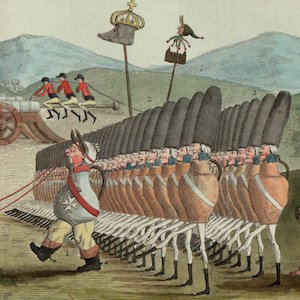Government

Gulhane Proclamation
This is an excerpt from an official proclamation by the government of the Ottoman Empire. The text is part of the Ottoman government’s response to internal and external demands for reform stemming from the growing weakness of the state.

Taking of the Bastille
This color print emphasizes the populace’s participation in the storming of the Bastille, showing the urban population fighting under a red banner with muskets, swords, and pikes against the royal soldiers.

Taking of Weapons at the Invalides
From the City Hall, the crowd that had gathered on the morning of 14 July crossed the Seine River and sacked the royal veterans’ hospital known as the Invalides, where it hoped to capture arms. In Berthault’s engraving, the scene appears chaotic.

Speech in the Garden of the Palais-Royal
In this artistic rendition, on 12 July 1789 Camille Desmoulins stands on a table and encourages his listeners to rise against the threat to the Estates–General. He, and others of his ilk, would be successful in bringing about the fall of the Bastille on 14 July.

Fusillade in the Faubourg St. Antoine, 28 April 1789
This image chronicles a riot. Many believe it was caused by artisans who attacked the Reveillon wallpaper shop and factory because they believed that the owner was about to lower wages. Over two days, more than 6,000 attacked the place. On 28 April troops were called and fired on the crowd.

National Assembly Relinquishes All Privileges
This image, part of a series produced to show the most important events of the Revolution, focuses on 4 and 5 August 1789, when the system of privileges came to an end. This legal structure, characteristic of the old regime, guaranteed different rights for different people.

Transportation of Voltaire to the French Panthéon, 8 July 1792
Although Voltaire’s contribution to the Revolution has been much debated, the revolutionaries themselves had absolutely no doubt of his significance. After 1789 he was much in vogue, in that his plays were often performed and other artists lionized him in various ways.

Arrest of Louis Capet at Varennes, June 22, 1791
This print shows an angry crowd of fervent revolutionaries breaking down doors to arrest the King.

Army of Jugs
This color drawing, produced in 1793 at the request of the Committee of Public Safety and then published as an engraving, caricatures the British army and its king, George III, as incompetent, who, despite fine uniforms, cannot defeat shoddily clad, yet energetic sans–culottes (on the left), who

An Ordinary Guillotine
The guillotine was first introduced as a humane, efficient, and above all modern form of execution in April 1792; during the radical phase of the Republic, it would become the symbol of the Terror. This engraving suggests the guillotine is providing "good support for liberty."